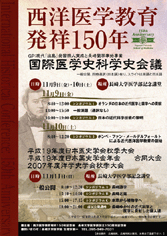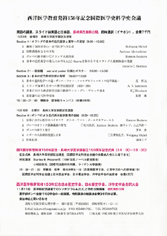| Wolfgang Michel: Frontier Crossing and Intellectual Curiosity - On the Road Toward the Modernization of Japanese Medicine. International Conference: 150th Anniversary of the Beginning of Modern Western-style Medical Education in Japan. Nagasaki University, 9 Nov 2007. [invited presentation] |
Wolfgang Michel
Frontier Crossing and Intellectual Curiosity - On the Road Toward the Modernization of Japanese Medicine |
In 1927, after traveling through China and Japan, the internationally renowned physiologist Ludwig Aschoff emphatically declared that there was no need for any kind of “medical mission” in Japan. This outstanding success owed much to Japan's modernization efforts during the second half of the 19th century, but its roots go back to the 17th century, when the establishment of a Dutch trading post and the permanent presence of European surgeons and physicians led to a gradually intensifying exchange of medical knowledge, books, instruments and pharmaceuticals. “Western Studies” in Japan as a response to European stimuli focused on military technology and medicine both at the beginning and in the final decades of the Edo period. Since 1650, as a result of skilful trading post surgeons and grateful high-ranking patients, new treatment methods, plasters and ointments filtered down throughout Japan. While the study of guns, canons and mortars had begun earlier, with the growing stability of the Tokugawa regime, official interest in weaponry receded for more than a century. However, medicine never ceased to attract Japanese physicians. This continuity in medical exchange was not merely the result of its obvious usefulness: Japanese physicians were less subject to the prevailing rigid social restrictions, and thus were in a better position than most of their countrymen to seek and to spread new knowledge. During the 15th and 16th centuries, Japan had absorbed a number of foreign innovations in smelting and forging methods and in papermaking, silk weaving, printing, etc. Although the country reduced its foreign trade and (diplomatic) relations to a few partners in 1639, the Japanese mind remained flexible in the ensuing decades. In view of internal and external adversaries, policy makers of the still-young Tokugawa regime had good reasons to stay alert. They were also well aware of their country's economic weaknesses, especially its dependence on certain imported commodities, among them materia medica.
Previous research has linked the rise of “Dutch Studies” (rangaku) to Shôgun Yoshimune, who, during the 1720s and 1730s, lifted an import ban on Western books, and promoted Dutch language studies and the import and local cultivation of drug plants. But a closer look into early sources reveals that medical and botanical books were never refused, and there had been a similar official request for foreign seeds, plants and pharmaceutical technology six decades earlier under Ietsuna.
Economics has always played a decisive role in a country plagued by meager natural resources and limited export capacities. To avoid the drain of silver and gold, efforts were made repeatedly to curb the influx of goods deemed to be unnecessary and to develop local resources. Western medicine, with its new recipes and expensive drugs, inevitably led to the search for local substitutes, thus stimulating Japanese botanical studies and the improvement of plant cultivation.Before the rise of large private academies specializing in “Dutch Studies”, such as the Tekijuku in Osaka and the Shirandô in Edo, the Japanese interpreters at the Dejima trading post played a pivotal role in the transmission of knowledge. Their command of the Dutch language was much better than Gempaku Sugita's famous memoirs, The Dawn of Dutch Studies, suggest. Some interpreter families with a long tradition in medical studies collected large numbers of books, manuscripts, and all kinds of instruments and objects. There was no way out of the country, but an education at these private schools provided a stimulating look at Western medicine and the world. Furthermore, here the young scholars met like-minded brothers from other regions. These educational stays in Nagasaki (Nagasaki yûgaku) were instrumental in establishing a network throughout the archipelago. From the mid-18th century, materia medica exhibitions (yakuhin-e) were organized in almost every region as a further means to exchange information and objects. In addition, as the tradition of copying texts never waned, despite a flourishing printing industry, manuscript copies of important medical writings can be found even in remote mountain villages. The Dejima trading post was also part of a vast network: the East India Company being responsible for integrating Japan into global trading systems. Dutch access to countries throughout Asia facilitated the accumulation and comparison of knowledge among European scholars. After the expulsion of the Portuguese from Japan in 1639, research on Japan depended on the interest and willingness of company employees working at the tiny island of Dejima and on the (sometimes risky) cooperation of their Japanese entourage. As medical instruction and deliveries of pharmaceuticals and other rarities helped to promote trade in textiles and other large-scale commodities, the company paid much attention to Japanese special requests. Since the 1650s, European surgeons had instructed physicians at Dejima, and the Nagasaki Inn (Nagasakiya), where the trading post chiefs and their physicians lodged during their stay in Edo, was a magnet for scholars, officials and sometimes even regional lords.
Through this Dutch cooperation, Japan managed to keep track of essential developments in the outside world, including in medicine and allied studies. There is no question that the Dutch-Japanese exchange was insufficient to provide a deeper insight into the theoretical background and the dynamic unfolding of modern medicine in Europe. Nevertheless, for about two centuries Japanese physicians acquired a great variety of treatment methods, an impressive amount of information on materia medica, a better understanding of human anatomy and the importance of anatomical studies, and a basic set of Western medical terminology. As most of this knowledge had spread even into rural areas, the ground was well prepared for the seeds that J. L. C. Pompe van Meerdervoort and his successors were to introduce.


